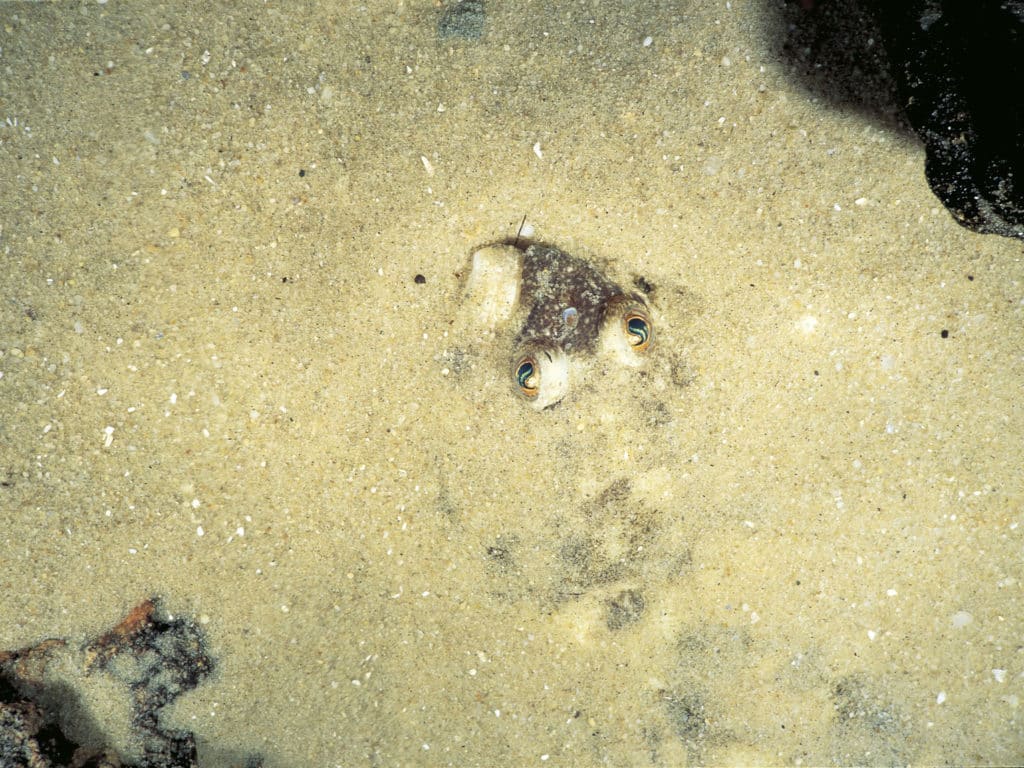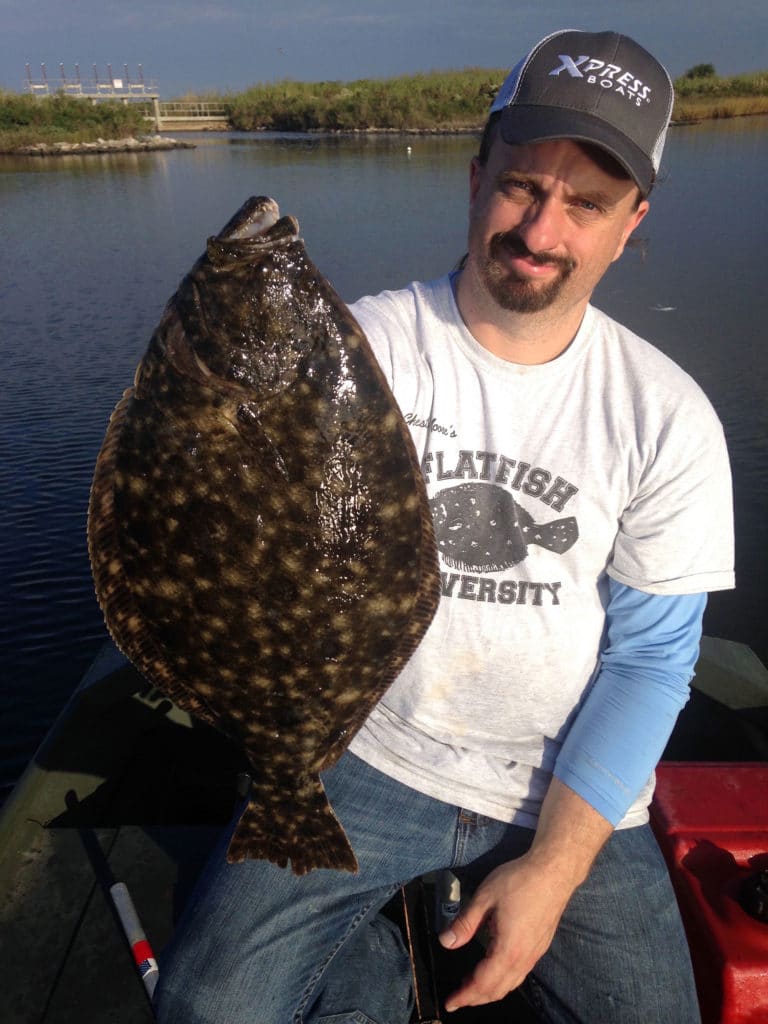
The bayous that wind through the Texas and Louisiana coastlines swarm with life during summer. From abundant alligators to pink-tinged roseate spoonbills, these bayous and the surrounding estuaries that feed into them delight wildlife lovers.
Many local anglers target these regions for redfish, and for good reason. These slow-moving water bodies feature thriving blue crab populations — a mainstay in a redfish’s diet.
Some bayous, however, also offer very good flounder fishing opportunities. Typically thought of as a fish of the fall and to a lesser extent spring, flounder still do bite during summer. They just seek areas with easy deep-water access.
Numerous bayous hold water from 8 to 15 feet deep, which is the sweet spot for flounder when temperatures soar. Learning to catch these flatties just takes a bit of an unorthodox approach.
A Legend’s Advice
Capt. Skip James is a flounder fishing legend. Having guided thousands of flounder-loving clients and appeared on many television fishing programs, his name is synonymous with flatfish in Texas and Louisiana. James passed away of natural causes last spring. As his friend for 25 years, I had the privilege of sharing his last conversations about flounder.

In one of those, he gave away a couple of specific secrets for fishing the deep bayous. “Big bayous with deeper water hold big flounder during summer. Look for the first big ‘S-Turn’ in the bayou. The sharper the turn, the better.,” he told me. “These are typically the deepest spots, and their odd shape helps create eddies that sort of trap baitfish and that brings in the flounder.”
These bayous can include those that pour into bay systems like Lake Calcasieu and East Galveston Bay as well as those up to five miles north of the bays in river systems. James told me he would fish either a 4-inch, glow-colored, twin-tailed beetle or a curl-tailed 4-inch grub, both tipped with a small piece of bait shrimp and rigged on a 1/4-ounce jighead.
“Rig that on a medium-heavy spinning rod and fish it with braided line. Crawl it slowly across the bottom. When the flounder thumps the jig, count to two and set the hook” he said.
James also told me something he said he rarely shared with the public during his guiding days — the value of shallow ponds in the bayous. “You’ll have a lot of little shallow ponds in the bayous that feed into them. On a low tide, they might only have 6 inches of water and only about two feet of water on a high tide. But when those tides are high there are lots of flounder in there.
“Fishing the first couple of hours of a falling tide as they drain can be incredible. Flounder spend most of their time in the deeper water of the main bayou but move up into the little ponds to feed on the shad. The fishing can be epic when the flounder start pouring out of there.”

Live Bait and Chumming
Capt. Derek York fishes the massive Galveston Bay Complex and said the deeper bayous on the eastern tier of that system can be solid for flounder during summer’s most brutal days. “Live bait is where it’s at,” he says.
The classic live mud minnow fished on a Carolina rig (an egg weight rigged above a swivel attached to a leader and hook) is hard to beat, he says. “I like to use a wide-gapped hook, so the fish is hooked in the corner of the mouth instead of swallowing it. In the old days, people used treble hooks, but we need to do a better job taking care of flounder, so the wide-gapped-style hook is best.”
York prefers outgoing tides, in general, but the best tidal flow for each particular bayou depends on many factors.
Live shrimp can also be extremely effective. A few years back, I watched a man fishing near me catch five flounder to my one using large live shrimp on a modified free-line rig. I was using a 2-inch Sassy Shad on a 1/8-ounce jighead, which usually works great for me. He had a wide-gap hook with a 1/8-ounce split-shot rigged above it, and he pitched into the current toward a point, allowing the current to push the bait into the key bite zone. The flounder hammered it.
The key to this seems to be the rig. The flounder don’t seem to want the shrimp on a heavy Carolina rig but could not resist the free-swimming action of that guy’s setup.
Although it’s not commonly practiced, chumming these locations can be effective. This is especially true for anglers in flat-bottom aluminum boats without trolling motors. Setting up along the mouth of the bayou, around the turns, bridge, pilings or other structures offers great chumming opportunities.
A chum bag tied off the back of the boat with cut menhaden, shrimp or even a can of jack mackerel with holes punched in it can bring flounder to you. If you start bringing in gafftops, quit chumming. These slimy catfish, which are common in the summer months, come to chum too and will steal your valuable bait.
Follow Menhaden Movements
The primary forage species of deep bayou flounder is menhaden (shad). At times they can be everywhere in the bayou systems, but they can also migrate as far as two miles in a single day, and the flounder follow them.
“We catch them like crazy one day in bayous on the Sabine River north of Sabine Lake, and then they’re gone. It’s all about the shad movement. If you find the shad in the bayous, you can find the flounder,” says dedicated flounder angler Frank Moore.
If you hit the S-Turns and mouth of the bayou but can’t find shad, cruise up the bayou until you start seeing active schools. “Look for nervous shad skipping along the surface and large schools swimming in the channel. Look for tidal switches to trigger bites. Falling tides usually bring shad back toward the front of the bayou, whereas days with super-long incoming tides can see them sort of migrate farther inland,” Moore says.

Early Flounder Migration
Flounder migrations don’t happen instantaneously. They occur in stages. The major flounder migration to the Gulf of Mexico that occurs in early November has its beginnings from late August to mid-September.
When the first cool fronts blow through and bring bluewing teal to the marsh, that signals the start of flounder migration. In my experience, flounder in the distant reaches of bayous begin to move up toward the main channels that intersect with the bay.
With each little front come more fish, and if you play your cards right, that’s a great time to score on big ones. This bite lasts a week or two, and then there’s a lull in flounder activity until the first arctic blast blows through the region.
Read Next: Fall, Wintertime Flounder on Micro Jigs
State of the Flounder Fishery
Flounder might seem plentiful on the Texas and Louisiana coasts but problems are brewing. Flounder numbers are much lower than both Texas Parks and Wildlife and Louisiana Department of Wildlife and Fisheries officials would like to see, and both states have taken action on creating limited season closures.
Conservative anglers take only what they can eat that day and always release the big fish (20 inches or better) to fight another day. That’s good fisheries stewardship that will help ensure flounder for generations to come.








